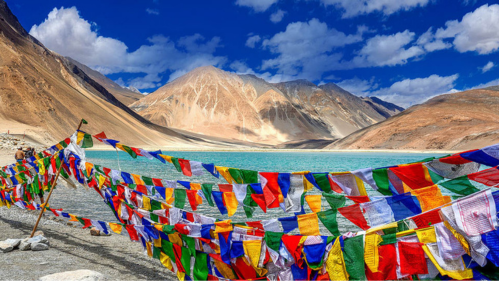Ladakh Tourism: Best Time to Visit, Attractions & Travel Tips
Ladakh, often called the "Land of High Passes," is a dream destination for travellers seeking adventure, tranquillity, and breathtaking landscapes. Nestled in the northernmost region of India, Ladakh tourism has gained immense popularity for its rugged mountains, serene monasteries, and thrilling road trips. Whether planning your first trip or returning to this paradise, knowing the best time to visit, top attractions, and essential travel tips will help make your journey unforgettable.
Best Time to Visit Ladakh
Ladakh tourism thrives in different seasons, offering unique experiences throughout the year. Here's a seasonal breakdown to help you decide when to visit:
Summer (April to June) – Peak Tourist Season- Best time for sightseeing, trekking, and outdoor activities.
- Comfortable temperatures range from 15°C to 25°C.
- Roads to Ladakh open up, making it accessible via Manali and Srinagar.
- Ideal for exploring Pangong Lake, Nubra Valley, and monasteries.
- Ladakh is a rain-shadow region, meaning minimal rainfall.
- Perfect for adventure seekers as the rivers swell, enhancing rafting experiences.
- Landscapes turn greener, offering a different visual treat.
- Occasional landslides may disrupt travel plans.
- Crisp weather and stunning golden hues of Ladakh's landscapes.
- Fewer tourists, making it a peaceful time to visit.
- Great for stargazing and enjoying the clear skies.
- Frigid temperatures, often dropping to -20°C.
- Ideal for winter treks like the famous Chadar Trek.
- Less crowded and perfect for those seeking solitude and snow-covered landscapes.
- Some high-altitude passes remain closed due to heavy snowfall.

Top Attractions in Ladakh
Ladakh tourism combines mesmerizing landscapes, ancient monasteries, and thrilling adventures. Here are some must-visit places:
Leh – The Heart of Ladakh
Leh, the capital of Ladakh, is the starting point for most travellers. Attractions in Leh include:
- Leh Palace – A 17th-century palace offering panoramic views of the town.
- Shanti Stupa – A white-domed Buddhist stupa known for its spiritual aura.
- Magnetic Hill – A unique optical illusion where vehicles appear to defy gravity.
Pangong Lake – A Picture-Perfect Destination
- Famous for its ever-changing shades of blue.
- Located at 4,350 meters and extends into Tibet.
- Best visited during summer when the lake is not frozen.
Nubra Valley – The Desert in the Mountains
- Home to the famous Hunder Sand Dunes and Bactrian camels.
- Diskit Monastery, with its massive Maitreya Buddha statue, offers stunning views.
- Accessible via Khardung La, one of the highest motorable passes in the world.
Tso Moriri Lake – A Hidden Gem
- A lesser-known but equally mesmerizing lake.
- Surrounded by snow-capped peaks, offering a peaceful retreat.
- Perfect for birdwatching, as it hosts migratory birds.
Monasteries of Ladakh – Spiritual and Cultural Hubs
- Hemis Monastery – The most prominent and wealthiest monastery, known for its vibrant festival.
- Thiksey Monastery – A stunning monastery resembling the Potala Palace in Tibet.
- Lamayuru Monastery – Situated in a moon-like landscape, offering a unique experience.
Travel Tips for an Unforgettable Ladakh Experience
To make the most of Ladakh tourism, keep these essential travel tips in mind:
Acclimatization is Key
Ladakh's high altitude can cause acute mountain sickness (AMS). Spend at least a day in Leh to acclimatize before exploring higher regions. Drink plenty of water and avoid strenuous activities initially.
Pack Smartly for Varying Climates
- Summer: Light woollens, sunscreen, sunglasses, and a hat.
- Winter: Heavy woollens, insulated jackets, gloves, and thermals.
- All Seasons: Sturdy trekking shoes and essential medicines.
Choose the Right Mode of Travel
- By Air: Leh's Kushok Bakula Rimpochee Airport connects Ladakh to significant cities.
- By Road: Manali-Leh Highway and Srinagar-Leh Highway offer scenic road trips.
- Bike Trips: Popular among adventure seekers, but ensure proper preparation.
Respect the Local Culture and Environment
- Ladakh is home to a rich Buddhist heritage. Be respectful at monasteries.
- Follow eco-friendly practices and avoid littering.
- Dress modestly and interact politely with locals.
Carry Enough Cash
ATMs are limited, and some areas have no card payment options. Keep enough cash handy, especially when travelling to remote areas.
Be Mindful of Restricted Areas
Some regions, like Pangong Lake and Tso Moriri, require Inner Line Permits for Indian travellers and Protected Area Permits for foreign tourists. Plan accordingly.
Stay Connected (or Disconnect!)
Only postpaid SIM cards work in Ladakh. While connectivity is improving, expect limited network coverage in remote areas. Enjoy the digital detox and embrace nature!
Conclusion
Ladakh tourism is an experience like no other, offering a perfect blend of adventure, spirituality, and breathtaking landscapes. Whether planning a road trip, seeking serenity by the lakes, or exploring ancient monasteries, Ladakh has something for every traveller. Choosing the right time to visit, exploring its stunning attractions, and following essential travel tips can make your Ladakh journey unforgettable.
So, are you ready to embark on the adventure of a lifetime? Pack your bags and get ready to witness the magic of Ladakh!

